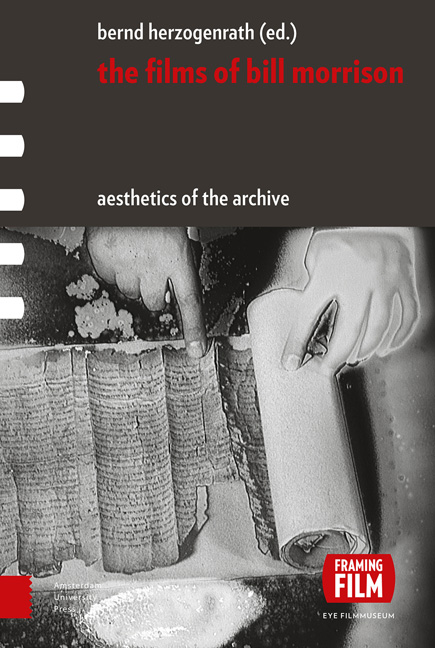Book contents
- Frontmatter
- Contents
- Acknowledgments
- Aesthetics of the Archive: An Introduction
- Chapter 1 Drafts and Fragments: Reflections around Bill Morrison and the Paper Print Collection
- Chapter 2 The Film of Her: The Cine-Poet Laureate of Orphan Films
- Chapter 3 Ghost Trip: Searching for Potential Myths
- Chapter 4 Decasia: The Matter | Image: Film is also a Thing
- Chapter 5 The Mesmerist: Illustrating the Return of the Repressed
- Chapter 6 Light is Calling: Celluloid Dreams
- Chapter 7 Gotham: Zoetrope: Block by Block
- Chapter 8 Outerborough: Early Cinema Revisited
- Chapter 9 The Highwater Trilogy: Thinking the Liquid – On the Ethics of Water and the Material Ecologies of Disaster and Ruination
- Chapter 10 Porch: Archives, Collective Memory, and the Poetics of Home Movies
- Chapter 11 The Future Lasts Long: The Romanov Lost Family Archives
- Chapter 12 Who by Water: Variations on Matter, Figures, Memory, and Mythology
- Chapter 13 Every Stop on the F-Train: Beyond and within the Restless Netherworld of (Manhattan’s) Mind
- Chapter 14 Spark of Being: Bachelor Machine
- Chapter 15 The Miners’ Hymns: Acts of Resurrection
- Chapter 16 Tributes – Pulse: A Requiem for the 20th Century: Death | Drive | Image
- Chapter 17 Just Ancient Loops: The Loops of Life in Intonation
- Chapter 18 The Great Flood: Water is Transparence Derived from the Presence of Everything
- Chapter 19 Re-Awakenings: Bill Morrison in Conversation
- Index of Film Titles
- Index of Names
- Index of Subjects
- Already Published
Chapter 15 - The Miners’ Hymns: Acts of Resurrection
Published online by Cambridge University Press: 12 December 2020
- Frontmatter
- Contents
- Acknowledgments
- Aesthetics of the Archive: An Introduction
- Chapter 1 Drafts and Fragments: Reflections around Bill Morrison and the Paper Print Collection
- Chapter 2 The Film of Her: The Cine-Poet Laureate of Orphan Films
- Chapter 3 Ghost Trip: Searching for Potential Myths
- Chapter 4 Decasia: The Matter | Image: Film is also a Thing
- Chapter 5 The Mesmerist: Illustrating the Return of the Repressed
- Chapter 6 Light is Calling: Celluloid Dreams
- Chapter 7 Gotham: Zoetrope: Block by Block
- Chapter 8 Outerborough: Early Cinema Revisited
- Chapter 9 The Highwater Trilogy: Thinking the Liquid – On the Ethics of Water and the Material Ecologies of Disaster and Ruination
- Chapter 10 Porch: Archives, Collective Memory, and the Poetics of Home Movies
- Chapter 11 The Future Lasts Long: The Romanov Lost Family Archives
- Chapter 12 Who by Water: Variations on Matter, Figures, Memory, and Mythology
- Chapter 13 Every Stop on the F-Train: Beyond and within the Restless Netherworld of (Manhattan’s) Mind
- Chapter 14 Spark of Being: Bachelor Machine
- Chapter 15 The Miners’ Hymns: Acts of Resurrection
- Chapter 16 Tributes – Pulse: A Requiem for the 20th Century: Death | Drive | Image
- Chapter 17 Just Ancient Loops: The Loops of Life in Intonation
- Chapter 18 The Great Flood: Water is Transparence Derived from the Presence of Everything
- Chapter 19 Re-Awakenings: Bill Morrison in Conversation
- Index of Film Titles
- Index of Names
- Index of Subjects
- Already Published
Summary
ABSTRACT
The Miners’ Hymns (2010) is a collaborative evocation of the working lives and landscape of the Durham Coalfields. It was commissioned for the 30th anniversary of the 1984-1985 Miners’ Strike, the final act that marked the end of the coalfield and a traditional way of life. Through the use of archive and an evocative score, the film exposes key elements of that tradition and the role the archive plays in the telling of their story. Simon Popple explores the nature of the collaboration, the role of the archive, and the universality of its subject.
KEYWORDS
archive, community, history, memory
Lord of the oceans and the sky above,
Whose wondrous grace has blessed us from our birth,
Look with compassion, and with love
On all who toil beneath the earth.
They spend their lives in dark, with danger fraught,
Remote from nature's beauties, far below,
Winning the coal, oft dearly bought
To drive the wheel, the hearth make glow.
Now we remember miners who have died
Trapped in the darkness of the earth's cold womb;
Brave men to free them, vainly tried,
Still their work-place remained their tomb.
– Gresford, The Miners’ Hymn. Robert Saint. c.1934INTRODUCTION: THEMES AND CONTEXTS
‘You find nothing in the Archive but stories caught half way through: the middle of things; discontinuities’ (Steedman 2002, 45).
The film archive is a tomb, another place where the dead sleep. It is of the past. Memories are frozen in a discontinued flow, embalmed as, ‘a defence against the passage of time’ (Bazin 1960, 4). They are visited intermittently, at moments of anniversary and respectfully resurrected for public display. They are sacred, inviolable, and closely guarded. At least they used to be.
We have now learned their real value and have recognized that they belong in the here and now. They speak as much about the future as of an imagined past. They transcend the enforced reverence of the museum, the gallery, and historical documentary, and demand to be animated in exciting and challenging ways. They sidestep the temporal and teleological orthodoxy of the historical document. They are -- and should be -- sites of contestation and creative experimentation wherein history can be reclaimed and evidential traces resurrected, performed, and creatively re-imagined.
- Type
- Chapter
- Information
- The Films of Bill MorrisonAesthetics of the Archive, pp. 227 - 240Publisher: Amsterdam University PressPrint publication year: 2017



